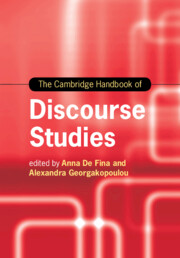Book contents
- The Cambridge Handbook of Discourse Studies
- Cambridge Handbooks in Language and Linguistics
- The Cambridge Handbook of Discourse Studies
- Copyright page
- Contents
- Figures
- Tables
- Contributors
- Preface
- Part I (Con)Textualizing Discourses
- Part II Perspectives and Modes of Analysis
- Part III Discourse Materialities and Embodiment
- Part IV (Trans)Locations and Intersections
- 17 Transnationalism, Globalization and Superdiversity
- 18 Translanguaging and Momentarity in Social Interaction
- 19 Intersectionality, Affect and Discourse
- 20 Expanding Academic Discourses: Diverse Englishes, Modalities and Spatial Repertoires
- Part V Ethics, Inequality and Inclusion
- Part VI Discourses, Publics and Mediatization
- Index
- References
20 - Expanding Academic Discourses: Diverse Englishes, Modalities and Spatial Repertoires
from Part IV - (Trans)Locations and Intersections
Published online by Cambridge University Press: 28 September 2020
- The Cambridge Handbook of Discourse Studies
- Cambridge Handbooks in Language and Linguistics
- The Cambridge Handbook of Discourse Studies
- Copyright page
- Contents
- Figures
- Tables
- Contributors
- Preface
- Part I (Con)Textualizing Discourses
- Part II Perspectives and Modes of Analysis
- Part III Discourse Materialities and Embodiment
- Part IV (Trans)Locations and Intersections
- 17 Transnationalism, Globalization and Superdiversity
- 18 Translanguaging and Momentarity in Social Interaction
- 19 Intersectionality, Affect and Discourse
- 20 Expanding Academic Discourses: Diverse Englishes, Modalities and Spatial Repertoires
- Part V Ethics, Inequality and Inclusion
- Part VI Discourses, Publics and Mediatization
- Index
- References
Summary
In this chapter we will discuss how scholarly understandings of academic discourse have shifted over the past thirty years in response to increasing globalization and changes in theorizations of language. We will look at how the definition of and boundaries around academic discourse have widened, shifting from a singular academic discourse to plural discourses, and from a focus on language to a focus on practices, in the process of accommodating more diverse Englishes. In particular, we will consider how the study of academic discourse has exposed the increasingly blurry boundaries not only between languages but also between modes, and how discourse includes not only text but also other resources for making meaning, such as images, sound, gesture and material artifacts. We will consider how English’s role as the academic lingua franca has influenced these shifting definitions and concepts. Finally, we will consider the implications of this diversification for pedagogy and for frameworks for future discourse studies.
Keywords
- Type
- Chapter
- Information
- The Cambridge Handbook of Discourse Studies , pp. 437 - 456Publisher: Cambridge University PressPrint publication year: 2020
References
Further Reading
This foundational text lays out a critical approach to the teaching of academic discourse, in which academic discourse is understood as a situated, historical, social and ideological practice, rather than a neutral product. Canagarajah examines many aspects of writing pedagogy (e.g. error correction, voice and plagiarism), looking at how teachers can accommodate the linguistic and cultural knowledge of multilingual writers.
This edited volume presents insightful discussions around various alternative forms of discourse that are now present in the academy. The chapters take up related issues including the role of traditionally non-standard discourses, dialects, hybridity and the new conditions engendered by multilingual students in composition courses and in writing across the curriculum.
This book discusses how the conventions of academic genres are formed and how they are creatively flouted. Tardy, an expert on academic genre, here offers insights from her own research on genre innovation, as well as guidance for teachers on incorporating innovation and playfulness into the teaching of academic genres.
This book argues for the value of code-meshing, the blending of African-American language styles with Standard English in academic discourse, as a way of empowering young people of color. The authors address the history of code-meshing, how this technique pushes back against racial segregation and negative stereotypes, and how it can be implemented in education.



